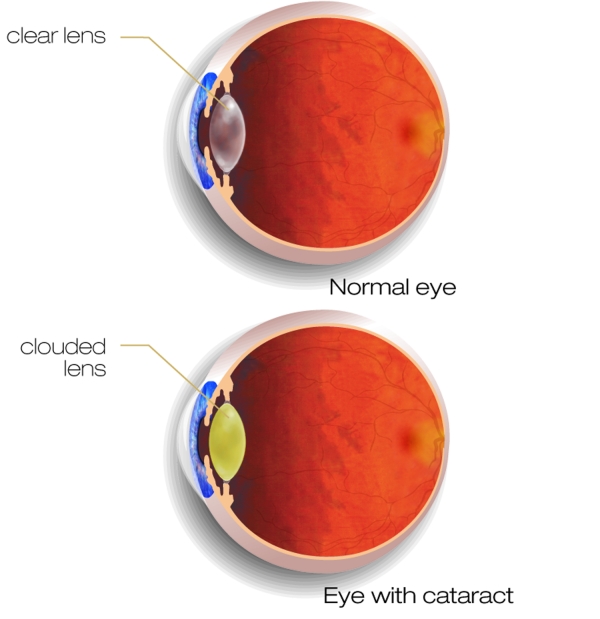The 5 Most Common Eye Injuries for Athletes
Sports and physical activities play a crucial role in maintaining a healthy lifestyle, but they also come with potential risks, including eye injuries

Cataracts are the most common cause of vision loss in people over age 40, making it the principal cause of blindness in the world. Most cataracts are due to age-related changes in the lens of the eye that cause it to become cloudy or opaque. But what is it that occurs with age that causes cataracts to form?
To understand the workings of the eye, many people compare how a camera works to that of how we see. For instance, the lens inside the eye works much like a camera lens, focusing light onto the retina for clear vision. It also adjusts the eye’s focus, enabling us to see things both up close and far away. Just like when a camera lens is fogged up or dirty and you get a resulting unclear picture — a similar process can occur with the lens of the eye.
The lens in our eye is mostly made up of water and protein. The protein is arranged in a precise way that keeps the lens clear and lets the light pass through it. But during the natural aging process, some of the proteins may clump together and start to cloud an area of the lens. The clouded lens tends to scatter light rather than transmitting it, therefore making it harder to see.
Currently, nobody knows for sure why the eye’s len changes as we age, forming cataracts. However, while the origin and development of age-related cataracts are not yet completely understood, researchers worldwide have identified certain factors associated with cataract development. Besides advancing age, cataract risk factors include:

Excessive Exposure to Ultraviolet Radiation From Sunlight
It’s well known that UV (ultraviolet) rays from the sun can cause skin damage and skin cancers, ultraviolet rays are also culpable in the formation of cataracts. Chronic exposure to sunlight can increase the risk of cataracts (as well as other conditions of the eyes) due to oxidative stress, a by-product of the sun’s damaging rays on our eyes.
Oxidative stress refers to harmful chemical reactions that can occur when our cells consume oxygen and other fuels to produce energy. It’s an unfortunate consequence of living, but it’s also considered a major contributor to normal ageing and age-related diseases; including cataract formation in the lens.
The cells within the lens contain mostly water and protein, and lack the organelles (literally “tiny organs”) typically found in other cells. This unusual make-up of lens cells renders the lens transparent, uniquely capable of transmitting light and focusing it on the retina at the back of the eye. However, excessive exposure to UV rays cause the proteins inside the eye to clump together and scatter light instead of transmitting the light normally. Therefore, oxidative stress is responsible for destroying the neatly ordered proteins inside the lens, which leads to the development of cataracts.
Diabetes
People with diabetes are more likely to develop vision-stealing cataracts compared to non-diabetics. The reason for this is because the eye’s lens gets its nutrients from the aqueous humor, a fluid filling the front portion of the eye. Aqueous humor provides oxygen and glucose, a simple sugar energy source for the body’s cells. When you don’t have good control over your glucose levels (as with unchecked diabetes), sugar levels rise in the aqueous humor and in the lens. High levels of glucose in the lens cause it to swell, affecting the clarity of vision.
The lens also has an enzyme that converts glucose into a substance called sorbitol. When sorbitol collects in the lens, it can affect cells and naturally-occurring proteins, causing the lens to become less clear and more opaque. This condition eventually leads to cataract formation, making the world around you appear blurry, yellowish or faded.
If you have diabetes, the best way to reduce your risk is to work closely with your doctor and maintain good blood glucose levels. Having the right glucose levels can help to keep the eye’s lenses clear and healthy.
Previous Eye Injury
Blunt trauma to the eye or damage to the eye from certain chemicals can change the tissue that makes up your eye’s lens. Penetrating ocular injury may disrupt the lens fibres or puncture the lens capsule, which can induce cataract formation either immediately or later on.
Obesity
Obesity is a health condition in which a person is significantly above his/her ideal weight and is typically gauged by body mass index (BMI), a ratio of weight to height. While obesity itself doesn’t cause cataracts, being obese or overweight can increase the risk of developing health conditions that are linked to cataracts such as diabetes and glaucoma.
Even if you are genetically predisposed to being heavier, you can still do your part to reduce your risk and improve your overall health by exercising, eating healthy and seeing your doctor for regular checkups.
Smoking
Research has found that smokers have double the risk of developing cataracts compared with non-smokers. This risk is tripled for heavy smokers. The reason for this is that smoking alters the cells of the lens through oxidation which contributes to the development of cataracts. There is also evidence that smoking leads to the accumulation of heavy metals like cadmium in the lens, which can be a significant cataract risk factor.
Family History
Family history is a major risk factor for developing cataracts. This means that if you have close relatives who have had cataracts your chances of developing cataracts is higher than those with no family history.
Significant Alcohol Consumption
Prolonged heavy drinking can seriously impact eye health including the formation of cataracts. This is because heavy drinking affects the absorption of vitamins in the liver which are needed to maintain healthy eyesight. For example, a vitamin B-1 deficiency due to alcohol consumption can cause a weakness or paralysis of the eye muscles.

Studies are inconclusive on cataract prevention, though many doctors agree that there are strategies you can use to help reduce your risk of cataracts and maintain overall eye health, such as:
Cataracts cannot be fixed with glasses, contact lenses or laser eye surgery. As scary as cataracts might sound, modern cataract surgery usually can restore vision lost to cataracts — and in some cases can reduce your reliance on glasses as well.
Cataract surgery is the most common eye operation performed in New Zealand and restores vision lost as a result of this condition. The microsurgery technique removes the damaged lens inside the eye that has become cloudy and replaces it with a new intraocular lens to restore vision. Being a short operation of fewer than 20 minutes and a hospital stay of around two hours means that the patient will be able to go home on the same day of the surgery. The visual results for cataract surgery are excellent, with most people achieving driving standard vision without glasses.
The ophthalmologists at Auckland Eye use the latest and most sophisticated techniques and equipment to ensure the best possible results. If you or someone in your life’s vision is affected by cataracts, visit our website to learn more about cataract surgery: https://www.aucklandeye.co.nz/vision-correction/cataract-surgery/
If you would like to learn more about cataract treatment, schedule an appointment with Auckland Eye and call 09 529 2481


Sports and physical activities play a crucial role in maintaining a healthy lifestyle, but they also come with potential risks, including eye injuries

For those leading an active lifestyle or engaged in sports, the significance of clear vision cannot be overstated.

Uncover the revolutionary technology behind LASIK that has empowered millions to enjoy clear vision without glasses.